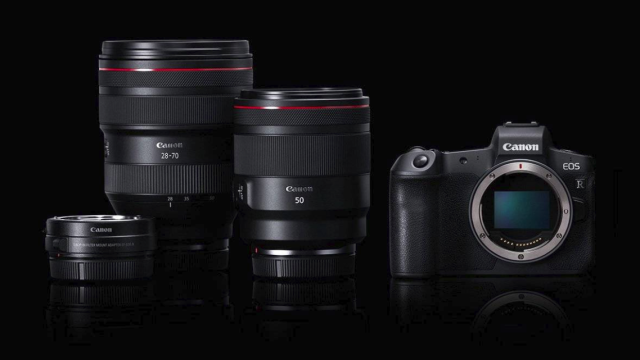It’s been a busy summer for camera aficionados with Nikon recently announcing its first high-end mirrorless camera. But now, things are about to get even more hectic thanks to the new Canon EOS R.
Like Nikon’s new Z cameras, the EOS R is Canon’s late response to the popularity of mirrorless cameras, a category which until recently has been been essentially dominated by Sony, especially when you’re talking about full-frame mirrorless cams. In fact, based on sales data gathered by NPD from the first half of 2018, Sony claims it recently became the number one seller of full frame cameras (both DSLR and mirrorless) in the U.S.
However, unlike Nikon, Canon opted to make just a single camera to compete with Nikon’s Z7/Z6 and Sony A7 III/A7R III, with the EOS R sporting a full-frame 30.3-MP sensor (slightly higher resolution than the 24.5-MP Z6, but much lower res than the 45.7-Mp Z7), an ISO range of 100-40,000 (about the same as the Z6 and A7 III), and an 8 fps continuous shooting rate that’s slower than both (the A7 III tops out 10 fps, while the Z6 is good up to 12 fps). Video recording capabilities are about what you’d expect with the EOS R supporting capture up to 4K at 30 fps, or full HD at 60 fps.
But of course, a good camera is much more than a cross section of those specs, and where Canon is hoping to get ahead is with its DIGIC 8 image processor and dual-pixel autofocus which features built-in eye tracking (like you get on a Sony A7), 5,655 total AF points, and low-light focusing capabilities that Canon says goes down to EV -6 (that’s extremely dark). Unfortunately, the EOS won’t have in-body image stabilisation, which is an important feature both Sony’s and Nikon’s rival include.
As for the EOS R’s new lenses, similar to what Nikon did for the Z7 and Z6, Canon made a new, larger RF-mount that lets Canon create sharper and more compact lenses for use on its mirrorless camera. At launch, the EOS R’s four native lenses look to be superior to what Nikon is offering on its Z cameras, with a lineup consisting of an RF 35mm f/1.8 prime macro lens, an RF 50mm f/1.2 prime lens, an RF 28-70mm f/2 zoom, and an RF 24-105mm f/4 zoom. That means not only will have Canon have one additional native lenses available for the RF to start, each one is as fast, or faster than the equivalent Nikon Z lens (aside from Nikon’s super specialised f/0.95 Noct lens, which still doesn’t have an official release date).
On every RF lens, Canon even added a built-in control ring that can be used to tweak aperture, shutter speed, ISO, and more, giving the EOS R easy two-handed adjustment. And for all the people with a large collection of EF-mount glass, Canon also made sure those lenses wouldn’t go waste by creating not one but three new lens adapters.
The standard EF-EOS R adaptor is the basic choice for adding compatibility with nearly all of Canon’s legacy glass, while the Control Ring Mount adaptor adds the same handy on-lens adjustment controls found on native EOS R lenses to older glass. The third Drop-in Filter Mount Adaptor, as its name implies, gives you the ability to swap in a variable neutral density filter, a polarising filter or a clear filter depending on the situation.
The EOS R’s body also has a few neat tricks as well, such as a 8cm LCD touchscreen that swings out and can even be flipped 180 degrees to point towards the front, while the EVF features an 3.69 dot OLED display with 100 per cent coverage and a 0.71x magnification. To the right of the viewfinder, there’s also a little touch sensitive navigation strip that can be swiped left and right to navigate through different menus and controls, or tapped in the center when you want to confirm a selection.
Ultimately though, the battle between Canon and Nikon may come down to cost and how many legacy lenses someone owns rather than image quality. We don’t have Australian pricing yet but The EOS R will be available from October 9 body-only for $US2,300, or $US3,400 as a kit with the 25-105mm f/4 lens. That’s slightly more expensive than the $US2,000 it’ll cost to get a Nikon Z6 or Sony A7 III, but a fair deal less than a $US3,000 body-only A7R III or $US3,400 (body-only) Nikon Z7.
The adapters will go for between $US100 and $US400 depending on if you opt for the standard EF-EOS R Mount adaptor, or go for the pricier Filter Mount adaptor with a neutral density filter.
